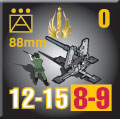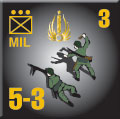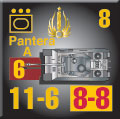| Blackshirt Division:
Publisher’s Preview
By Mike Bennighof, Ph.D.
October 2022
 A while back, I wrote a piece for Daily Content about the Blackshirt “M” Armored Division, complete with a variant for the long out-of-print Bitter Victory. At the same time, I sketched out what the division might look like in Panzer Grenadier format; it’s an old habit. Eventually that became Blackshirt Division, a Panzer Grenadier supplement with a set of 10 scenarios in which the M Armored Division – a division of battle-tested Blackshirts equipped with the latest German-made vehicles and weapons - sets out to battle the Americans in North Africa. There are 88 new downloadable playing pieces (that means you’ll have to assemble them yourself) showing the Blackshirt outfit in its own special color scheme. A while back, I wrote a piece for Daily Content about the Blackshirt “M” Armored Division, complete with a variant for the long out-of-print Bitter Victory. At the same time, I sketched out what the division might look like in Panzer Grenadier format; it’s an old habit. Eventually that became Blackshirt Division, a Panzer Grenadier supplement with a set of 10 scenarios in which the M Armored Division – a division of battle-tested Blackshirts equipped with the latest German-made vehicles and weapons - sets out to battle the Americans in North Africa. There are 88 new downloadable playing pieces (that means you’ll have to assemble them yourself) showing the Blackshirt outfit in its own special color scheme.
Raised to provide Benito Mussolini with a politically reliable “palace guard” of combat-tested troops (the implication being they could defeat a coup attempt by the Royal Italian Army if needed), the M Division was much smaller than a German panzer division, following a blend of German and Italian practices developed in the Western Desert campaign.
Whether it was ever really intended for combat operations is unclear; the Germans definitely believed it would be retained in Italy to prop up Mussolini. And despite what Wikipedia says, it was definitely never intended for deployment on the Eastern Front (Wikipedia articles filled with strange made-up crap . . . who could ever imagine such a thing?).
 Mussolini, however, wanted to show the Germans what “his boys” could do, and pressed for their commitment to action. But the division was not ready for combat by the time the campaign in Tunisia had ended, nor were they ready to deploy to Sicily a few months later. They ended up never seeing action, and unable to keep Mussolini in power, either. Their tanks and weapons would be confiscated by the Germans and issued to their own troops. Mussolini, however, wanted to show the Germans what “his boys” could do, and pressed for their commitment to action. But the division was not ready for combat by the time the campaign in Tunisia had ended, nor were they ready to deploy to Sicily a few months later. They ended up never seeing action, and unable to keep Mussolini in power, either. Their tanks and weapons would be confiscated by the Germans and issued to their own troops.
Our set of scenarios of course sends them into combat, because we can. The set isn’t based on some grand alternative history setting, just a tiny what-if question: what if the M Division had begun formation just a month or two earlier, and then proceeded through training at a reasonable pace (without the Royal Army’s interference)?
The Blackshirts are well-armed, at least on the board (they have no artillery support of their own). And their morale is usually pretty good; their leadership is serviceable (while the officers were supposedly selected for their combat experience, dedication to Fascism was the foremost requirement). Their higher command is not very good, and that translates into low initiative in many scenarios.
The scenarios take place in Tunisia in early 1943, with the M Division spearheading counter-attacks against the encroaching Allied armies in hopes of keeping the bridgehead around Tunis and Bizerte intact. The Blackshirts most often face off against the Americans, who are not all that good; the U.S. Army is poorly led, poorly trained and in many ways poorly equipped.
One area where the Americans are notably superior to the Blackshirts is in artillery. The M Division does not have any conventional field artillery, relying instead on the German-made 88mm anti-aircraft gun. This provides some indirect fire capability, and a very potent anti-tank defense. Royal Italian Army armored divisions made this switch in the Western Desert, trading their inadequate artillery for 88mm guns and the Italian equivalent, the Ansaldo 90mm. The 132nd “Ariete” Division used theirs to decisive effect at the Battle of Gazala in 1942, and Italian organizers felt that the change had been vindicated.
Against the British and their Imperial allies, the change made great sense. But the American way of war, just starting to be developed in Tunisia, put great emphasis on artillery and air power – dealing with all obstacles, human or material, by smothering them with mountains of high explosives. “If it gets in your way, blow it up.” Without artillery of their own to fire counter-battery missions against the awesome American 105mm howitzers, the M Division is at a serious disadvantage in a number of scenarios (they have to face a lot of American artillery that would otherwise have been suppressed).
 But the Blackshirts have a few marks in the plus column. Their infantry has seen combat in Greece or Russia, and is as good as that of the Germans. They are organized on the Italian pattern rather than the German table, but the difference at this scale is not that great. The big difference for the Blackshirts is in their machine gun platoons. Like the Royal Italian Army’s AS42 organization scheme, the MVSN units are well-equipped with automatic weapons. Unlike the Riyal Army, which still wields the awkward, strip-fed Breda M37 machine gun (and sometimes even less useful older models), the Blackshirts have the German-made MG42 with a rate of fire almost five times that of the Breda. But the Blackshirts have a few marks in the plus column. Their infantry has seen combat in Greece or Russia, and is as good as that of the Germans. They are organized on the Italian pattern rather than the German table, but the difference at this scale is not that great. The big difference for the Blackshirts is in their machine gun platoons. Like the Royal Italian Army’s AS42 organization scheme, the MVSN units are well-equipped with automatic weapons. Unlike the Riyal Army, which still wields the awkward, strip-fed Breda M37 machine gun (and sometimes even less useful older models), the Blackshirts have the German-made MG42 with a rate of fire almost five times that of the Breda.
Italy designed an armored personnel carrier – a wheeled vehicle based on a truck chassis – but never deployed one operationally. The M Division troopers get to ride into battle in German-designed SPW 251 armored half-tracks, here designated the Br.81. Breda built other German half-tracks under license, as prime movers for heavy artillery pieces, but not troop carriers. For the Blackshirt Division, we’ve given them this license as well.
While the Royal Army makes do with the 47mm anti-tank gun – a very good weapon at the start of the war, and one still capable of knocking out many Allied tanks by 1943 – the Blackshirts have the far more capable German-made 75mm PaK 40. While not as awesome as the 88mm guns of the artillery regiment, this gun is a match for any Allied tank that might be found in Tunisia.
And then there are the tanks: the reason for the M Division’s existence, and also the reason why it never entered combat – the MVSN could not train enough drivers and mechanics quickly enough to operate the division’s vehicles, and the Royal Army would not transfer any of its experienced men to the hated Blackshirts.
 The most powerful tank available to the Blackshirts – and by far the most powerful to see action in any of the scenarios – is the German-designed Panther tank. The Germans did not provide any of these vehicles to the M Division in 1943, as all German production of the new tank went to the panzer divisions preparing for Operation Citadel, the attack at Kursk. But the tank’s manufacturer, Daimler-Benz, reached a license agreement with Fiat-Ansaldo in February 1943. Ansaldo did not produce any Panthers before Italy surrendered in September. It would have taken enormous effort, and non-existent German cooperation, to bring the factory on-line in time to send any Italian-built Panthers to Tunisia. But it could, just barely, have been done so the Blackshirt Panther is included in the set. The most powerful tank available to the Blackshirts – and by far the most powerful to see action in any of the scenarios – is the German-designed Panther tank. The Germans did not provide any of these vehicles to the M Division in 1943, as all German production of the new tank went to the panzer divisions preparing for Operation Citadel, the attack at Kursk. But the tank’s manufacturer, Daimler-Benz, reached a license agreement with Fiat-Ansaldo in February 1943. Ansaldo did not produce any Panthers before Italy surrendered in September. It would have taken enormous effort, and non-existent German cooperation, to bring the factory on-line in time to send any Italian-built Panthers to Tunisia. But it could, just barely, have been done so the Blackshirt Panther is included in the set.
The Blackshirts did take delivery of the latest model of the German Army’s workhorse, the PzKpfw IV. With a long-barreled 75mm gun, good armor protection and good speed, the PzKpfwIVF2 (here styled P26/42, following Italian nomenclature) is better than any Allied tank. Alongside it is the latest model of the PzKpfw III, the N model equipped with a short-barreled 75mm gun for infantry support. Under the Italian system, the tank is called the M24/42 (medium tank, 24 tons, model 1942).
And they also have late-model German-made StuGIIIG assault guns, low-slung armored vehicles with a long-barreled 75mm gun intended to support the infantry but useful in an anti-tank role as well. Under the Italian system they’re called the Semovente 75/42. The reconnaissance group has eight-wheeled German-made armored cars as well.
What the Blackshirt tankers don’t have is very good training, or any experience in armored warfare. Therefore the Blackshirts, despite their impressive armament, do not have Armor Efficiency or tank leaders. These deficiencies greatly hinder their combat effectiveness.
Blackshirt Division is a fun little addition to An Army at Dawn (you only need An Army at Dawn to play all of its scenarios). You can send Mussolini’s Best into action and see if they justified his enormous confidence in them.
You can download Blackshirt Division right here.
It’s $15.99, but if you’re a Gold Club member, it’s free to you as part of the Golden Library (there’s no Gold Club discount or freeness through Wargame Vault).
Click here to join the Gold Club
See your Gold Club Insider newsletter for ordering information.
Golden Chipboard
 Ten (10) chipboard sheets, slightly thicker than the ones we use for game pieces, for use in pasting up your own counters from our downloadable games and expansions. Ten (10) chipboard sheets, slightly thicker than the ones we use for game pieces, for use in pasting up your own counters from our downloadable games and expansions.
You can order Golden Chipboard right here.
Sign up for our newsletter right here. Your info will never be sold or transferred; we'll just use it to update you on new games and new offers.
Mike Bennighof is president of Avalanche Press and holds a doctorate in history from Emory University. A Fulbright Scholar and NASA Journalist in Space finalist, he has published a great many books, games and articles on historical subjects; people are saying that some of them are actually good.
He lives in Birmingham, Alabama with his wife, three children, and new puppy. He misses his lizard-hunting Iron Dog, Leopold.
Want to keep Daily Content free of third-party ads? You can send us some love (and cash) through this link right here.
|
